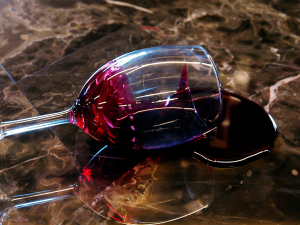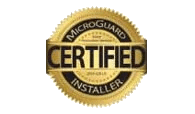
Sealing Natural Stone
Everything (and then some) You Ever Wanted to Know About Sealing Your Natural Stone
Are you a little confused about whether or not to seal your natural stone? You’ve done your homework and researched the topic on the web only to find that there are opposing opinions on the topic. Most experts recommend sealing all stone while others emphatically state that not all natural stone needs to be sealed.
STONE ABSORBENCY TEST
To get a general idea of how absorbent the stone is, place several drops of water on the surface of the stone and time how long it takes for the water to completely disappear. If the water disappears in under one minute, consider the stone very porous.
If it takes up to 3-4 minutes, consider it porous. If it takes more than 3-4 minutes, consider it slightly porous. This simple test will also give a good indication of the quantity of sealer needed to protect the entire area.
SO WHAT IS THE ANSWER?
Let’s make it simple. To be safe, let me say that for the most part, all stone surfaces should be sealed for maximum protection. The worst case when you are dealing with a stone that is not very porous is that the stone will absorb very little sealer to achieve maximized protection. Don’t look the cost of the sealer as a waste of money though. Consider it added peace of mind.
(Tip: see the about testing absorbency first. If your stone is not very absorbent, buy only a very small bottle of sealer.)
Caveats
New Countertops? Some granite countertops are pre-sealed. Ask your fabricator or perform the Stone Absorbency Test (see above).
Resined Stones: If the stone is resined, it may not need sealing. Perform the absorbency test to be sure.
Choosing the Correct Sealer
Many factors need to be considered when choosing the correct sealer.
- Stone type: Many, if not most stones today are resined at the factory. Resining adds strength to more fragile stones thus creating a much larger supply of natural stones that can be used. You can learn more about resining by searching the Knowledge Base at stoneandtilepros.com. All stone is not created equal. How porous a stone is and how fast it will absorb a liquid is called the absorption coefficient. This coefficient is extremely important when choosing a sealer.Granite generally will have a higher absorption coefficient than a polished marble. Limestone can be extremely absorbent. The higher the absorption coefficient, the more difficult it will be to seal the stone adequately. (See sidebar for Stone Absorbency Test)
- Stone finish: The finish on a stone affects its absorption coefficient. A polished surface will be less absorbent than a honed or flamed finish. The above absorption test will determine how absorbent a stone is.
- Stone location: Where is the stone located? Is the stone on the floor, wall, countertop? Is it in a kitchen, foyer, lobby, bathroom? What are they chances of it being subjected to spills or staining agents? Exposure to water, oil, heavy traffic, pets, etc. all need to be taken into consideration when choosing the proper product for protection. For example, a marble kitchen floor that is used daily will need a sealer that has both oil and water repellant properties. At the other end of that spectrum, dealing with a front foyer may only need a water repellant sealer.When protecting a busy hotel lobby floor, don’t be falsely assured that a wax coating will provide the optimal solution. It may track and scuff too easily, requiring costly upkeep. A quality impregnator and a polishing program may be needed to maintain the shine and protection.
- Current Maintenance: How is the stone maintained? Is it exposed to harsh cleaning chemicals not intended for natural stone? On the other hand, if maintenance is neglected, a stone floor will have ground-in dirt and grit and if it has a high polish it will be worn. In this case, no matter how well it is protected, it will get dirty and dull. For example, a moderately busy hotel lobby floor that gets dust mopped and wet mopped every day may need a good quality impregnator. On the other hand, a stone foyer floor located in a home and not receiving any traffic does not need daily cleaning. An application of a water repellant impregnator may be all that’s necessary.The type of stone, its finish, its location, and how it is maintained all need to be considered when determining how to protect it. Evaluate each of these parameters carefully.How do we protect stone and other porous materials from staining? There are so many sealers on the market today. Which ones are best? Which ones really work?It can be very confusing trying to choose a sealer to protect stone. In the past several years the stone restoration and janitorial industries have bombarded the market with hundreds of products to seal, protect and polish stone.Fortunately, all of these products fall into only two major categories:
- Coatings
- Impregnators (Penetrating) Sealers
Coatings:
Coatings are sealers that place a sacrificial coating on top of the stone acting as a barrier to prevent water, oil and dirt from entering the pores of the stone.
Coatings can be classified into two general types:
- Strippable
- Permanent
Strippable Coatings
Strippable coatings are coatings that are designed to be easily stripped or removed from the surface of the stone. These coatings are made of polymers consisting of acrylics, styrene, polyethylene and others. They are usually water based. Many of the janitorial products are water based polymer type coatings. To identify these coatings look for terms on the label such as “metal cross link,” “high solids,” “high speed,” “acrylic,” “thermoplastic,” etc. When in doubt, ask. There are hundreds of different formulas of strippable floor coatings.
Most of them are designed for resilient tile floors and not for stone. If a coating is to be used, be sure it is specified for stone.
Permanent Coatings
Permanent coatings are coatings that are very difficult to remove. They are made of solvent based polymers such as polyurethane, epoxies, etc. These are not recommended for stone.
Impregnators (Penetrating) Sealers
Impregnators are designed to penetrate below the surface of the stone and deposit solid particles in the pores of the stone or to coat the individual minerals below the surface of the stone. Water, oil and dirt are restricted from entering the stone.
Impregnators can be solvent or water based and usually contain silicone, siloxane, silane, methyl silicate or other similar silicon derivatives. The latest impregnators now contain fluoropolymers
Impregnators may also be classified as Oleophobic /Lyophoic (oil repelling) or Hydrophobic (water repelling).
Hydrophobic impregnators are designed to repel only water and water-based chemicals. Fruit drinks, coffee, tea, soda, etc. would be repelled by a hydrophobic impregnator.
1 Infused with resins at the factory to increase strenght and density.
2 Fluorocarbons are also lipophobic and oleophobic.
3 Lipophobicity, also sometimes called lipophobia (from the Greek λιποφοβία from λίπος lipos “fat” and φόβος phobos “fear”), is a chemical property of chemical compounds which means “fat rejection”, literally “fear of fat”. Lipophobic compounds are those not soluble in lipids or other non-polar solvents. From the other point of view, they do not absorb fats.
“Oleophobic” (from the Latin oleum “oil”, Greek ελαιοφοβικό eleophobico from έλαιο eleo “oil” and φόβος phobos “fear”) refers to the physical property of a molecule that is repelled from oil.
The most common lipophobic/oleophobic substance is water.
Oleophobic Impregnators
Oleophobic impregnators are designed to repel water and oil based liquids. Cooking oil, grease, body oils, etc. would be repelled by an oleophobic impregnator.
An oleophobic impregnator will always be hydrophobic, but a hydrophobic impregnator may not be oleophobic. Be sure to read product labels carefully to determine if they it is limited to being only hydrophobic. Some products are listed as oil resistant. Oil resistant and oil repellant are entirely different. Oil resistant will only slow down the absorption of oil into the stone. Oil repellant will prevent oil from entering the stone. Again, read product labels carefully. Be sure you are buying the right product for your particular situation.
NOTE —- Impregnators with Fluoropolymers are both oleophobic and hydrophobic.
IMPORTANT: Impregnators will do nothing to protect acid-sensitive stones from etching. They are designed to penetrate the stone’s surface to create a shield to protect staining agents from penetrating below the surface of the stone. Etching occurs on the surface of the stone.
COATING OR IMPREGNATOR?
How do you make the determination between a coating or an impregnator? They both have their advantages and their disadvantages. The following summary should be considered carefully when choosing the proper product:
Coatings – Advantages
Coatings are sealers that place a protective, sacrificial layer on the surface of the stone.
- Coatings are generally economical. The initial application is relatively low.
- Coatings are generally easy to apply. Unskilled labor can learn to apply them in a short time.
- Coatings generally will provide a sacrificial coating on the stone. This layer will take most of the wear, preventing wear on the stone.
- Certain coatings will provide added slip-resistance. (Although there are slip resistant treatments available just for natural stone surfaces.)
- Coatings can be applied below grade. If a floor is located below ground level, a good coating may prove beneficial for protecting or waterproofing.
- Coatings will generally provide various degrees of luster.
Coatings – Disadvantages
- Since most coatings are typically softer than the stone itself, they will usually scratch, mar and scuff very easily, showing traffic patterns soon after application. This will require frequent buffing, burnishing or re-application.
- Coatings can build up and can cause an unsightly appearance, producing an unnatural, wavy, plastic look to the stone.
- Poor quality coatings can turn yellow. This is especially true if the stone is exposed to UV light.
- Coatings require frequent stripping and reapplication. The chemicals and abrasives used in the stripping process may cause damage to the stone. Typically, certain stripping pads and stripping brushes can scratch some softer stones.
- Some wax strippers can harm certain stones such as agglomerates, eating away at the polyester binders.
- Certain coatings may block the breathing capability of the stone. Moisture can become trapped below the surface and may lead to spalling.
Impregnators – Advantages
- Most impregnators will not change the appearance of the stone.
- Most impregnators do not require frequent applications. Since the impregnator is below the surface, it will generally last several years before reapplication is necessary.
- Most impregnators are not affected by UV light since they are below the surface where UV light cannot penetrate. For this reason they can be used outdoors.
- Impregnators are typically hydrophobic, while some are oleophobic.
Impregnators – Disadvantages
- Impregnators that are solvent-based produce noxious and flammable vapors during application.
- Solvent-based impregnators are harmful to the environment producing high VOCs (volatile organic compounds). For this reason, some are restricted in certain states. Always check the Safety Data Sheet (MSDS/SDS).
- Impregnators require a semi-skilled person for application. Proper training is highly recommended.
- The initial cost of most impregnators is relatively high.
- Impregnators in general cannot be used below grade to resist hydrostatic pressure. Since the stone is still capable of breathing, water can be forced through the stone by pressure.When choosing the proper product for protection, the above guidelines should help. Always talk with the manufacture or distributer, and let them know where you plan to use their product. They can be very helpful if you tell them all the conditions that apply.
Sealing: Do it Yourself or call in a PRO?
SEALING: DIY or Call in a Pro?
Is sealing a job for the homeowner, or should you hire a qualified professional to do it for you? Consider the following pros and cons:
The obvious pro for doing it yourself is you save on labor costs. However, if it is not done correctly it could result in problems.
For example, the surface must be thoroughly and completely cleaned. If not, you take the chance of sealing in dirt and debris. Also, keep in mind that the sealer is intended to fill the pores and coat the exposed minerals in the stone, not to coat the surface. If residual sealer is not completely removed from the surface of stone, it may cause problems, including a haze on the stone’s surface that may develop as the sealer dries. Once it has dried completely, sealer can be very difficult to remove, often requiring professional assistance.
Different sealers perform differently in different environments and on different stones. Hiring a pro to do the job may end up saving you in the end. A pro will know which is the best sealer for the job and will use equipment and techniques that allow them to get the job done efficiently.











